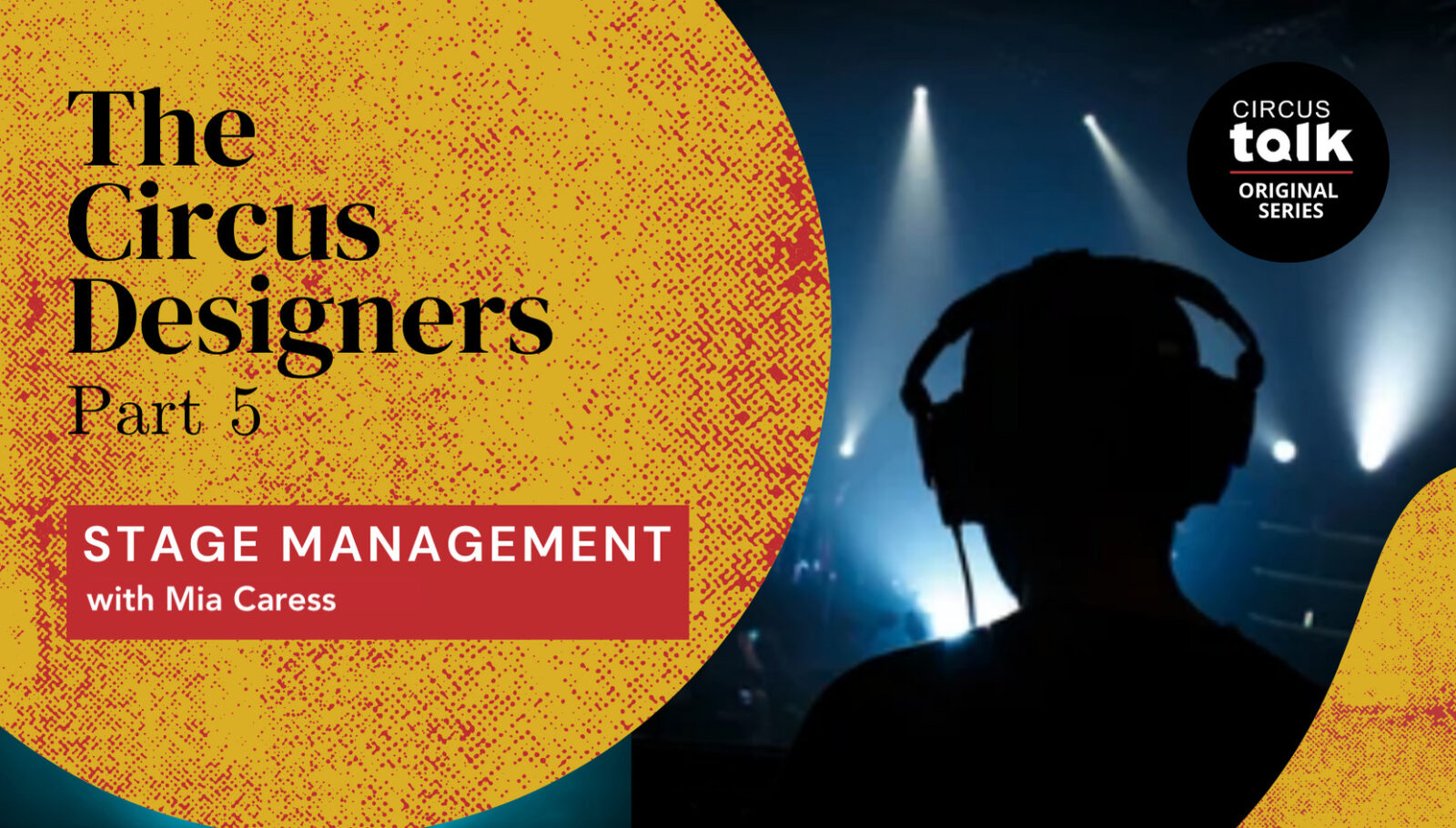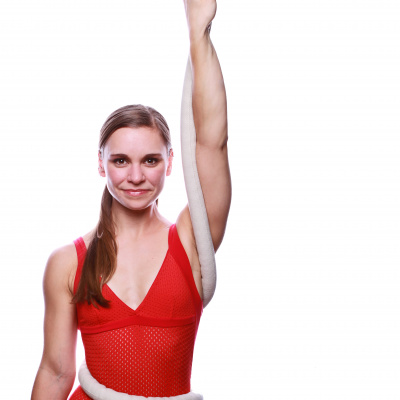The Choreography of Stage Management with Mia Caress
Any role in a circus production could be considered — to use an old idiom — a cog in the wheel. But if there is one person that has the honor and responsibility of turning the crank that sets the whole machine in motion, it’s the stage manager. This final article of The Circus Designer Series pays homage to the specialized expertise of circus stage managers. I had the absolute pleasure of chatting with Mia Caress, a performer, production manager, and stage manager who hails from four generations of circus folk. “My great-grandparents had a dog act with Ringling. My grandmother was raised on the show. She did head-to-head and hand-to-head on the wire with her sister. My grandfather rigged my grandmother’s act, and they drove to various cities. He used to pack his eyelids with tobacco to stay awake on the road. Isn’t that crazy? My mom was raised on the road with Ringling, training in everything, as kids do with the circus. She grew up in a sixty-foot trailer where they would go out and shoot their dinner wherever they were.”
Caress noted the differences in her upbringing compared to her ancestors, but she also emphasized how circus people always felt like home: “Circus people reading this article will understand that there’s a certain type of person that feels really familiar.” Caress recalled growing up around the Show Folks of Sarasota, Florida. “Even if I’d met them for the first time, there was something about them that spoke to me as a kindred spirit.”
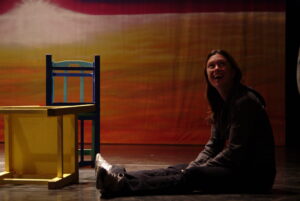
Caress trained as a dancer, but (call it what you like: roots, home, destiny) her career flowed back to circus. She danced with Cirque Le Masque, and because she understood the scope of circus, quickly “moved through the ranks to dance captain, rehearsal director, stage manager, and then ultimately production manager. We toured nationally and internationally for about twelve years,” she explained. The show ran “primarily in proscenium theaters, traditional houses, which can be a great fit for circus, but you do have to make it that. My niche was being able to take a circus show and put it into a venue that was not accustomed to having circus.” The show ran from September to June. Caress filled the summers with production work for rock and roll, so her experience waxed and waned from teams of fourteen to two or three hundred. With such a scope of expertise (and as I have done in previous articles), I asked Caress to describe what exactly a stage manager does.
Advancing the Show
“Gosh! Let’s start at the beginning. You go into rehearsals before you go on tour and start to learn the show. You work with the choreographer and designers and start to understand all of the pieces of the production.” Because the show often went to venues unfamiliar with circus, Caress had to be an expert liaison. “I would advance the show with a deep understanding of what circus looks like, what the production looked like, what the venue looked like, and how to marry those three to bring in the show that we wanted to do,” she said. I was reminded of ‘advance men’ arriving in towns weeks before Circus Day to plaster posters, arrange for supplies, and barter tickets for marketing. Nowadays, “advancing the show means that you are getting in touch with the Technical Director of the venue, sending them your technical rider, your lighting plot, and communicating with them about props.”
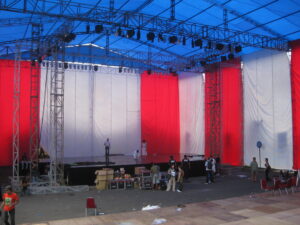
Upon arrival, Caress would work with the Master Electrician and lighting designer. The rigger approved the truss for aerial work, and some lights (specials and booms in the wings) would have to be focused. “You don’t need a big crew when you’re loading in because nobody wants anybody to touch their props. We had very stringent rules. None of the locals that we hired for backstage work that were not traveling with our show were allowed to touch anything. I think this is pretty unique to circus. Ordinarily, when you have a load-in everybody else does a lot of the work, and as a stage manager, you direct. But when you’re working with a small company with props and gear that need to keep you safe, nobody touches it but us.” This was one example of circus-specifics while touring to a multitude of venues.
While most of her experiences have been copacetic, Caress mentioned, “There was often pushback about our [lighting] plot.” Lighting trees in the wings are an anomaly in traditional theater shows, “and you’d have to explain that, if you didn’t have them, you actually couldn’t see the show.” So Caress would explain the intricacies of lighting a rolla bolla or juggling act. Educating her colleagues was part of the job. She recalled watching crew members pull rigging lines for aerial acts for the first time. “It’s really incredible to share something that they’re not going to forget. We’re not going to go into a venue and be just another show. Everything is different than what they’ve done before.”
One Billion Hours
After loading in, tech rehearsal began—or as Caress put it (and I chuckled), “you spend one billion hours in the theater trying to get together the sound, lights, and rigging.” Once the cues are set, a cue-to-cue rehearsal follows so performers can check their lighting, sound, and props, and Caress can examine the show flow. Caress expanded, “This show is not ‘press play and go,’ because lots of things can go sideways during a performance, and they [the crew] have to be really careful to listen to me on the headset the whole time. I know if something is going wrong, if the rigging is not coming in properly. I can tell if a performer can’t see their prop.”
These phases of a production are familiar to anyone in the business, but to hear them through Caress’s eyes humbled me. Circus stage managers—those that turn the crank of the show machine—must be so knowledgeable of every facet of a production: lights, sound, costume, rigging, and the variety of circus disciplines. I wondered how Caress’s career as a performer affected her work as a stage manager. “I’m so comfortable on a stage and with patterns of people, and that’s really important with circus. I can envision a table moving out and a point coming in,” she said, her hands miming these actions, “and dancers being down here, and where the stagehand needs to come from. The patterns of it are innate for me.” This made sense. Caress’s dance training has primed her to see the choreography of stage management and to be masterful at orchestrating the complexities of an entire production.
G-O
The house opens, the audience arrives, and the stage manager settles into yet another role: calling the show. “Calling a show means telling each department to stand by for their next action.” Caress held up an index finger as she explained, “You never say it before you actually say it: ‘Wait for my g-o.’ When you hear ‘go’ over the headset, somebody is expected to act. If someone’s asleep at the rail, and you say the word ‘go,’ someone is all of a sudden doing something.” She gave me a real-time example. “Stand by spot one to pick up artists entering downstage left.” A pause. “Spot one, go.”
Caress explained that lights, sound, and rail cues have their own numbers. “Light standby for cue one. Cue one, go.” Caress would sometimes add physical descriptions of the next action, particularly for the rail. Calling a show takes a thorough understanding of every single gear of the machine coupled with an artistic finesse as to the timing of each action, shift, and transition. The stage manager knows just how fast or slow to set the gears in motion, and can predict where a cog might get stuck and how to troubleshoot it in real time.
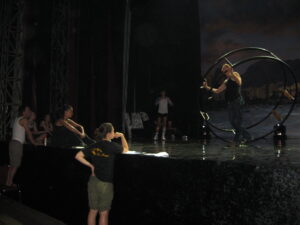
While much has changed since advance men arrived in towns with lithograph posters, there was a general familiarity in Caress’s story that remains the same. “After the show, we were pretty quick to load out (an hour, maybe ninety minutes), go back to the hotel and sleep, and be on our way to the next venue the next day.” Arrive, set up, perform, pack up, travel, and do it all over again the next day in a new town: the cyclical nature of touring circus. “The whole thing is such an experience for me because I find all of it to be theatrical, not just with what the performers are doing, but the coordination of the people it takes to make it happen.”
Come on, girls!
Caress’s family history and performance career have honed her to be an excellent circus stage manager, but she was insistent that anyone could enter this business and be successful. We spoke about university programs or venues that offer apprenticeship-like positions that will train folks in a bit of everything. She encouraged, “Reach out to local theaters, or even arenas. There are performing arts happening in so many places, so find out where performances are happening, and call them and say, ‘Hey, I’m interested in doing this. Do you have a program like this?’ People want you to be involved. We love this job, and we’re psyched when somebody wants to do it!”
Caress also specifically extended an invitation to women and girls. “Come on, girls! Let’s get in there. We can do it! It’s so nice to have other women interested in this kind of work in which we need more women.” Her enthusiasm stemmed from two places: a distinct lack of women in stage tech roles and her positive lived experiences. “I’m ordinarily the only woman. Maybe, maybe there is another woman, but most of the time, no. It’s hard hours, it’s extreme labor, but there are women who can do it. I could do it, and so I wonder why it’s not more attractive to women. It’s such interesting and fun work.” Caress debunked the cliché that the work environment might be unwelcoming to women. “I’ve worked in hundreds [of venues]. I can think of two where I had a problem.” Caress mentioned, “I went in with the confidence of knowing what I know, and nobody gave me a hard time.”
“People grow up wanting to be all sorts of things.” … Caress hopes that more women will “get recruited by other people in the business. Not just other women in the business.”
She wondered (in a slightly challenging tone), “Where are the programs that pitch to women? Why don’t girls get into this line of work when they’re young? People grow up wanting to be all sorts of things. I’ve never met another girl that’s like, ‘I really want to be a stagehand.’ Never.” Caress hopes that more women will “get recruited by other people in the business. Not just other women in the business.” Furthermore, it seemed incongruous to Caress why anyone would shy away from this work or feel like they didn’t fit in. The benefits and the lifestyle, to her, are obvious. “It’s amazing being on the road. I got paid to see the world ten times over.” She also noted, “Don’t feel limited to your home city. The work is out there. People love this work and want to have you.” If you’re willing to put in the hours, the opportunities to work in tech are abundant and global.
Paralleling the global opportunities tech and stage management can offer, Caress was fervent about correcting a common misuse of the word circus. “I get so frustrated when people use the expression, ‘It’s such a circus,’ as though it’s some negative saying. I am on a mission to change that. Because if anybody had the opportunity to actually work with a circus, you’ll see that it is the most inclusive place on Earth. If everything could work as a circus, we would be a much better world because we would support each other. There’s no language barrier, there’s no sex preference barrier, there’s no gender barrier, nothing. It doesn’t exist. It’s just this. It’s just circus people.”
Final Bow
The goal of this series can be summed up in a single gesture: a raised arm to the back of the house, an open palm to the tech booth. It’s the signal to the audience to join the performers in a moment of gratitude to the designers, the crew, the stage managers, and the production teams that create spectacular circus worlds and keep the whole machine running safely. Please join me in a standing ovation for circus designers, production teams, and technicians. I raise my arm to you all, and thank you for your expertise and your wisdom.
...Do you have a story to share? Submit your news story, article or press release.

